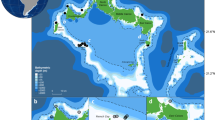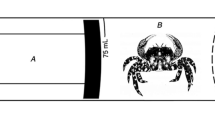Summary
The relationship between oxygen consumption and body length was determined for eight larval chironomid species in Bear Lake, Utah-Idaho. Respiration was measured by the micro-Winkler method in 1-cc tuberculin syringes filled with lake water and lowered to lake bottom. A total of 144 measurements of O2 consumption was made.
Oxygen consumption for all individuals was related to body length by a power function. On a double log plot the relationship was a straight line and by least squares regression was Y = 2.26X−1.72, where Y is log10 oxygen consumption (µliters/animal per hour) and X the log10 body length (millimeters). Correlation coefficient (r) was 0.884.
The measurements in the lake were taken over a naturally occurring range of oxygen concentration of 5 ppm, but deviations from regression were not associated with differences in concentration. Body length covered a range from 1.5 to 12.6 mm, and the species represented carnivores and herbivores as well as different-aged in-stars.
For some chironomid larvae at least, body length seemed preferable to other body size measurements because of ease in determination and reasonable precision.
Zusammenfassung
Das Verhältnis zwischen dem Sauerstoffverbrauch und der Körpergrö\e wurde an 144 Chironomidenlarven von acht verschiedenen Arten im Bear-See an der Grenze von Utah and Idaho bestimmt. Die Atmung der Tiere konnte mittels der Micro-Winkler-Methode in 1 ccm gro\en Glasbehältern gemessen werden. Diese Behälter waren zuerst mit Seewasser gefülltt and dann zum Grund des Sees herabgelassen worden.
Der Sauerstoffverbrauch der einzelnen Tiere zeigte im Verhältnis zu ihrer Körperlange einen gradlinigen Verlauf auf doppellogarithmischem Papier. Eine Regressionsanalyse mittels der Methode der kleinsten Quadrate ergab die Gleichung Y = 2,26 X-1,72, wobei Y den Logarithmus des Sauerstoffverbrauchs in Mikrolitern pro Stunde pro Tier, and X den Logarithmus der Körperlange in Millimetern darstellt. Der Korrelationskoeffizient dieser Analyse betrug 0,884.
Die Sauerstoffkonzentration im See war nicht gleichmä\ig sondern variierte fiber eine Spanne von 5 Promill. Diese Variation beeinflu\te aber nicht die Standardabweichung von der Regressionslinie. Die Körperlänge der Larven erstreckte sich von 1,5 bis 12,6 Millimeter. Die Larven gehörten fleischfressenden und pflanzenfressenden Arten an and befanden sich in verschiedensten Alterstadien der Entwicklung.
Die Messung der Körperlange erschien, zumindest für einige Chironomidenlarven, leichter and mit guter Genauigkeit bestimmbar zu sein, als dies mit anderen Körpermassen der Fall ist.
Similar content being viewed by others
References
Edmondson, W. T. - 1955 - The seasonal life history of Daphnia in an Arctic lake. Ecology 36: 439–455.
Edwards, R. W. - 1958 - The relation of oxygen consumption to body size and to temperature in the larvae of Chironomus riparius Meigen. J. Exp. Biol. 35: 383–395.
Engelmann, M. D. - 1961 - The role of soil arthropods in the energetics of an old field community. Ecol. Monogr. 31: 221–238.
Fox, H. M. & Wingfield, C. A. - 1938 - A portable apparatus for the determination of oxygen dissolved in a small volume of water. J. Exp. Biol. 15: 437–455.
Fremling, C. R. & Evans, J. J. - 1963 - A method for determining the dissolved oxygen concentration near the mud-water interface. Limnol. Oceanogr. 8: 363–364.
Fry, F. E. J. - 1957 - The aquatic respiration of fish, p. 1–63. In: M. E. Brown (ed.), The physiology of fishes. Vol. I. Acad. Press, New York, 447 pp.
Iyengar, V. K. S., Davies, D. M. & Kleerekoper, H. - 1963 - Some relationships between Chironomidae and their substrate in nine fresh-water lakes of southern Ontario, Canada. Arch. Hydrobiol. 59: 289–310.
Keister, M. & Buck, J. - 1964 - Respiration: some exogenous and endogenous effects on rate of respiration, p. 617–658. In: M. Rockstein (ed.), The physiology of Insecta, Vol. III. Acad. Press, New York, 692 pp.
Macfadyen, A. - 1963 - Animal ecology aims and methods. 2nd ed. Pitman and Sons, Ltd. London, 344 pp.
Ostle, B. - 1963 - Statistics in research. 2nd ed. Iowa State Univ. Press, Ames, 585 pp.
Prosser, C. L. & Brown, F. A. Jr. - 1961 - Comparative animal physiology. 2nd ed. Saunders Co., Philadelphia, 688 pp.
Richman, S. - 1958 - The transformation of energy by Daphnia pulex. Ecol. Monogr. 28: 273–291.
Sublette, J. E. & Sublette, M. S. - 1965 - Family Chironomidae, p. 142–181. In: A catalog of the Diptera of America north of Mexico. Agri. Handbook No. 276. U.S.D.A., Washington.
Teal, J. M. - 1957 - Community metabolism in a temperate cold spring. Ecol. Monogr. 27: 283–302.
Tilly, L. J. - 1968 - The structure and dynamics of Cone Spring. Ecol. Monogr. 38: 169–197.
von Bertalanffy, L. - 1964 - Basic concepts in quantitative biology of metabolism. Helgol. Wiss. Meeresunters. 9: 5–38.
Zeuthen, E. - 1953 - Oxygen uptake as related to body size in organisms. Quart. Rev. Biol. 28: 1–12.
Author information
Authors and Affiliations
Rights and permissions
About this article
Cite this article
Erman, D.C., Helm, W.T. Estimating oxygen consumption from body length for some chironomid larvae. Hydrobiologia 36, 505–512 (1970). https://doi.org/10.1007/BF00039803
Received:
Issue Date:
DOI: https://doi.org/10.1007/BF00039803




